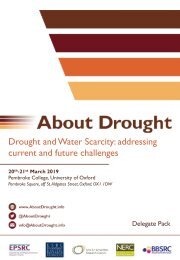About Drought Handbook: Outputs & Impacts
As the UK’s £12m Drought and Water Scarcity (DWS) research programme reaches its conclusion with a final event at The Royal Society in London, this handbook draws together the key outputs and outcomes. The book also features a series of interviews with our leading stakeholders, which highlight how successfully we have met our objectives to produce cutting-edge science that has made a demonstrable impact on how decision-makers manage water scarcity in the UK.
As the UK’s £12m Drought and Water Scarcity (DWS) research programme reaches its conclusion with a final event at The Royal Society in London, this handbook draws together the key outputs and outcomes. The book also features a series of interviews with our leading stakeholders, which highlight how successfully we have met our objectives to produce cutting-edge science that has made a demonstrable impact on how decision-makers manage water scarcity in the UK.
- No tags were found...
Create successful ePaper yourself
Turn your PDF publications into a flip-book with our unique Google optimized e-Paper software.
Credit: David Throup/EA<br />
Informing the Water Industry<br />
Environment Agency<br />
“<strong>About</strong> <strong>Drought</strong> has informed the water industry, now we need some sort of<br />
mechanism to identify the most useful outputs from strategic to operational<br />
products. We must not let those fall through a crack now that <strong>About</strong> <strong>Drought</strong><br />
has finished.”<br />
Paul Crockett, Principal Officer, National Water Resources Planning Framework, Environment Agency<br />
“<strong>About</strong> <strong>Drought</strong> has helped<br />
generate a step change in thinking<br />
around what is possible and what<br />
can be done, and over the next 10<br />
years or so we will be making better<br />
decisions, using better tools because<br />
of it,” says Paul Crockett who is<br />
leading the modelling work on the<br />
National Water Resources Planning<br />
Framework for the Environment<br />
Agency.<br />
Yet Paul, who has worked closely<br />
with the MaRIUS project and <strong>About</strong><br />
<strong>Drought</strong> (ENDOWS), believes<br />
there is still more to be done in<br />
encouraging the water industry to<br />
catch up with the latest outcomes<br />
of the programme’s data and tools.<br />
<strong>About</strong> <strong>Drought</strong> has supported the<br />
water industry in both strategic<br />
planning and real-time decisionmaking<br />
during a time when it has<br />
come under pressure to collaborate<br />
across water company boundaries<br />
on regional forward planning, as well<br />
as approaches to dealing with issues<br />
as they arise with a greater level of<br />
accountability.<br />
MaRIUS and ENDOWS have<br />
held a series of workshop events<br />
specifically for the industry, working<br />
alongside key stakeholders to match<br />
its research to their needs.<br />
With the National Water Resources<br />
Planning Framework driving water<br />
companies to work together to build<br />
resilience into water management<br />
with clear, joined-up direction from<br />
Government departments, agencies<br />
and water regulators, the industry<br />
is now more ready to be receptive,<br />
Paul feels.<br />
He says: “There are a lot of great<br />
products from MaRIUS and <strong>About</strong><br />
<strong>Drought</strong> but the water industry –<br />
the customer, if you like – is only<br />
just seeing the potential.”<br />
Historic <strong>Drought</strong>s’ work in<br />
reconstructing reliable rainfall,<br />
river flow and groundwater data<br />
back to 1890, as well as providing<br />
standardised drought indices<br />
has been important in putting<br />
events into context, improving<br />
the industry’s understanding of<br />
statistics, the latest methodologies<br />
and stakeholder needs. There is still<br />
more to be done in migrating data<br />
from the academic models to those<br />
the water companies use.<br />
The water resource model<br />
developed by MaRIUS is being<br />
adopted for use by Paul’s team, to<br />
help the National Water Resources<br />
Planning Framework assess the<br />
potential effects of different types<br />
of drought and climate change<br />
impacts at a national scale, and test<br />
7<br />
management strategies.<br />
Paul’s concern is that with the<br />
impacts of climate change starting<br />
to be felt on the reliability of water<br />
availability, it is the wrong time to<br />
bring <strong>About</strong> <strong>Drought</strong> to an end.<br />
He says: “It’s so important to have<br />
<strong>About</strong> <strong>Drought</strong> following on from<br />
the original research projects; it<br />
demonstrated what is possible, the<br />
better knowledge and insight we<br />
can get from the information that<br />
decisions will be based on in the<br />
future. The team really helped to<br />
educate the industry rather than<br />
just educating other academics.<br />
“We need to look at the tools<br />
we can use to take it even further<br />
forward now that the industry is<br />
starting to buy into it more.<br />
“<strong>About</strong> <strong>Drought</strong> has informed the<br />
water industry, now we need some<br />
sort of mechanism to identify the<br />
most useful outputs from strategic<br />
to operational products. We must<br />
not let those fall through a crack<br />
now that <strong>About</strong> <strong>Drought</strong> has<br />
finished.<br />
“<strong>About</strong> <strong>Drought</strong> is to be applauded<br />
for what it has done but it needs<br />
more time and resources if it is to<br />
maximise the outcome for UK plc<br />
of all this research.”<br />
Interview by Sally Stevens




